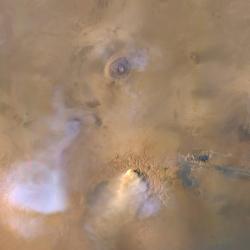Planetary aeronomy
BIRA-IASB has built up a long-standing expertise in state of the art studies of the atmospheres of our sister planets Mars and Venus.
The study of these Earth-like planets, whose atmospheres have evolved towards different and extreme conditions, is a vital part of the understanding of the past and future of our subtle climate system.
BIRA-IASB has taken a lead position in this domain with the development, operation and data processing of the NOMAD instrument on board the European ExoMars mission.
We are proud to present a new introductory film, in which the Royal Belgian Institute is being presented in all its facets. Discover the many fields of research and societal challenges in which the Institute is active.
ESA’s next mission to Venus, EnVision, was officially ‘adopted’ today by the Agency’s Science Programme Committee. BIRA-IASB will be on board with the VenSpec-H instrument.
ESA, the European Space Agency, has downselected the shortlist for its next ‘medium’ science mission to three finalists: M-Matisse, Plasma Observatory and Theseus.
The ExoMars Trace Gas Orbiter (TGO) has revealed how oddly ‘light’ carbon monoxide forms in Mars’ atmosphere. The finding paints a better picture of how carbon-containing matter can be formed on the Red Planet without life, and helps clarify a puzzling discovery made by NASA’s Curiosity rover last year.
On 13 April 2023, the ESA spacecraft JUICE will take off on board an Ariane 5 launcher from ESA’s Spaceport in Kourou, French Guyana. After an 8-year-long journey, JUICE will investigate Jupiter and its icy moons, with a special focus on Ganymede, the largest moon in the solar system.
The James Webb Space Telescope captured its first images and spectra of Mars on September 5, 2022. The telescope’s remarkable infrared sensitivity provides a unique perspective on our neighboring planet, complementing data collected by orbiters, rovers, and other telescopes.
BIRA-IASB researchers have published their Mars data calibration in the journal Planetary & Space Science.
Comets contain contain organic material older than the solar system, as is shown by data gathered by the DFMS instrument, which flew on board the Rosetta spacecraft to study comet Chury. An instrument and discovery to which BIRA-IASB scientists and engineers have contributed.
The Space Pole in Uccle opens its doors to the public on September 24 and 25, 2022.
All through the summer and until October 31 of this year, you can find information on RoadMap (ROle and impAct of Dust and clouds in the Martian AtmosPhere) and other ongoing Mars research at the exhibition “ExoMars: Europe’s new era of Mars exploration” at Astropolis in Ostend, Belgium.
Two years after its launch, ExoMars Trace Gas Orbiter (TGO) settles in its final orbit around Mars. The satellite carries the instrument NOMAD of the Royal Belgian Institute for Space Aeronomy (BIRA-IASB) on board.
By combining observations from three international spacecraft at Mars (including BIRA-IASB's NOMAD instrument), scientists were able to show that regional dust storms play a huge role in drying out the Red Planet.
New findings from the ESA-Roscosmos Trace Gas Orbiter set new upper limits on how much methane, ethane, ethylene and phosphine is in the martian atmosphere – four so-called ‘biomarker’ gases that are potential signs of life.
BIRA-IASB is sending an instrument to Venus. The VenSpec-H instrument will fly with the EnVision mission, which has just been selected by ESA and is planned for launch in 2031-2032.
ESA-Roscosmos ExoMars Trace Gas Orbiter has detected a new gas for the first time. Sea salt embedded in the dusty surface of Mars and lofted into the planet’s atmosphere has led to the discovery of hydrogen chloride. The spacecraft is also providing new information about how Mars is losing its water.
The brand new RoadMap (ROle and impAct of Dust and clouds in the Martian AtmosPhere) project has just kicked off. Three years long an enthusiastic team of scientists and engineers from Belgium, Denmark, Germany, and Spain will work together to unravel some of the remaining Martian mysteries.
The UGent Armand Pien public observatory is reopening its doors to the public today, and has prepared a lot of fresh Mars science for you: an exhibition, a Mars-themed night and an online crash course.
The NOMAD instrument, developed at the Royal Belgian Institute for Space Aeronomy and currently in orbit around Mars on board ESA's ExoMars Trace Gas Orbiter, has detected a unique green glow of oxygen in the atmosphere surrounding the red planet, similar to that of polar aurora's on Earth.
The Royal Belgian Institute for Space Aeronomy (BIRA-IASB) is working on a future ESA mission to Venus, called EnVision. The spacecraft is currently scheduled for launch in 2032, and its aim will be to investigate the geological characteristics and activity of Venus, as well as its influence on the planet’s atmosphere.
Belgian scientists can detect meteors and meteorites falling in or around Belgium. The Museum of Natural Science in Brussels has six meteorites that fell in Belgium.
NASA’s Curiosity rover reported the highest burst of methane recorded yet. However, neither ESA’s Mars Express nor the ExoMars Trace Gas Orbiter recorded any signs of the elusive gas.
Prestigious journal Nature publishes two papers describing the first results of the Belgian NOMAD instrument on board ExoMars Trace Gas Orbiter.

